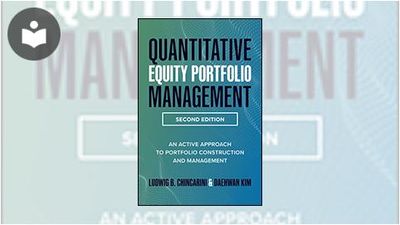Quantitative Equity Portfolio Management, Second Edition: An Active Approach to Portfolio Construction and Management
- 11h 59m
- Daehwan Kim, Ludwig B. Chincarini
- McGraw-Hill
- 2022
Construct and manage a high-performance equity portfolio using today's most powerful quantitative methods
The classic guide that taught a generation of investors how to build high-yield quant portfolios, Quantitative Equity Portfolio Management has been fully updated with new data, research, information, and insights, along with the latest, most powerful quantitative tools and methods.
Renowned quant experts Ludwig Chincarini and Daehwan Kim walk you through the foundational principles of quantitative active management and explain how to build an equity portfolio using those powerful concepts. They provide clear explanations of all the topics you need to know—from basic models, factors and factor choice, and stock screening and ranking to fundamental factor models, economic factor models, and forecasting factor premiums and exposures. Inside, you’ll find:
- Proven methodology for creating an equity portfolio that maximizes returns and minimizes risks
- Techniques for to create a professionally managed portfolio
- Practical melding of financial theory with real-world practice
- Illustrative financial examples and case studies
Every chapter has accompanying practical problems with solutions and labs using real data available online. In addition, the book as a whole has online appendices covering a brief history of financial theory, fundamental models of stock returns, a basic review of mathematical and statistical concepts, an entertaining explanation and quantitative approach to the casino game of craps, and other on-target supplemental materials.
Quantitative Equity Portfolio Management delivers everything you need to build a solid equity portfolio for your clients.
About the Author
Ludwig B. Chincarini, CFA, PhD, is professor of Finance in the School of Management at the University of San Francisco and Director of Quantitative Strategies for United States Commodity Fund Investments. As a member of the academic council of Index IQ, he was instrumental in creating and developing some of the newest alternative ETFs. Chincarini was on the academic council of Future Advisor, one of the early Robo-Advisor firms, which was bought by Blackrock in 2015. Chincarini also co-developed the S&P 500 equal-weight ETF and index and helped build one of the first basket trading firms with automated procedures to manage hundreds of quant portfolios. He received his PhD from MIT.
Daehwan Kim, PhD, is a professor in the Department of Economics at Konkuk University, South Korea. Previously, he taught at American University in Bulgaria, Ewha Womans University School of Public Policy, Korea University, Aalto University Executive Program, NUCB Business School in Japan, and Nizhny Novgorod State University in Russia. He worked for FOLIO Investing as a financial economist and for First Private Investment Management in Frankfurt as a senior portfolio manager, and he has advised several hedge funds and investment companies based in East Asia. He received his PhD from Harvard.
In this Book
-
Foreword
-
Notations and Abbreviations
-
The Power of QEPM
-
The Fundamentals of QEPM
-
Basic QEPM Models
-
Factors and Factor Choice
-
Factor Definition Tables
-
On Data Mining and Techniques to Adjust the Significance of Factors
-
Stock Screening and Ranking
-
A List of Stock Screens Based on Well-Known Strategies
-
On Outliers
-
Converting Z-Scores to Returns
-
Fundamental Factor Models
-
Economic Factor Models
-
Forecasting Factor Premiums and Exposures
-
Portfolio Weights
-
Quadratic Programming
-
Advanced Techniques for Quadratic Optimization
-
Rebalancing and Transactions Costs
-
Approximate Solution to the Optimal Portfolio Problem
-
An Exact Solution to the Optimal Portfolio Problem
-
An Approximate Optimal Portfolio with Market Impact Costs
-
Tax Management
-
Leverage
-
Fair-Value Computations
-
Derivation of Equations (12.21), (12.22), and (12.23)
-
Tables of Futures Leverage Multipliers Needed to Achieve Various Degrees of Leverage
-
Market Neutral
-
Market-Neutral Portfolio Construction Techniques
-
Bayesian α
-
Performance Measurement and Attribution
-
Style Analysis
-
Measures of Opportunity
-
Short Returns
-
Measuring Market Timing Ability
-
The Backtesting Process
-
Factor Formulas
-
The Portfolios’ Performance
-
Glossary



